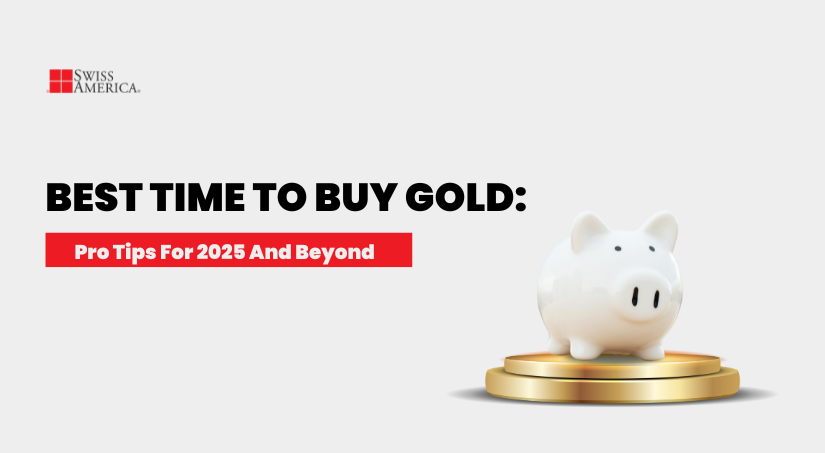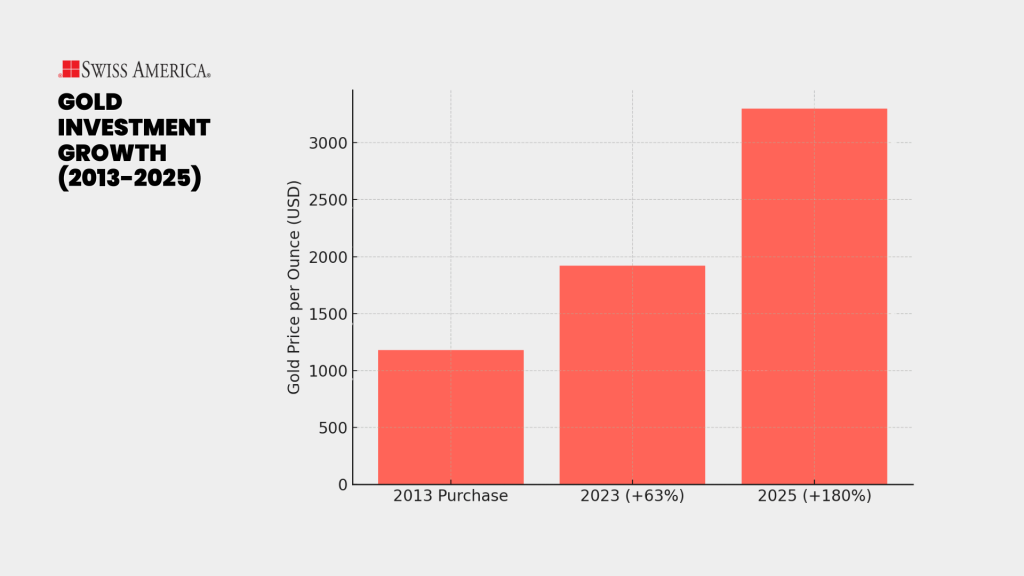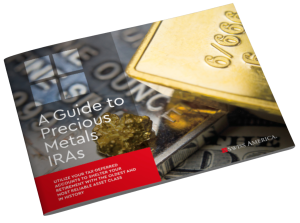
As of this writing, gold prices have climbed 33% over the past year. If you’re considering adding this precious metal to your portfolio, you’re probably wondering about the best time to buy gold. Have you missed the boat, or is there still opportunity ahead?
The outlook suggests continued strength. According to the World Gold Council’s spring 2025 survey, 95% of central bankers expect gold purchases to increase over the next year, which could drive prices even higher. With this backdrop, here are our thoughts on timing your gold investment and the key factors you should consider.
Buying gold based on market data
Gold has protected wealth and beaten inflation for decades, but you need to hold it long-term to see those benefits. Trying to jump in and out based on daily price moves usually doesn’t work.
What really drives gold prices is trouble. Economic downturns, inflation spikes, wars, and elections. Gold is a safe haven asset when people get scared about their money. If you’re seeing a lot of uncertainty in the news, that’s usually when gold prices increase. Since gold has been an investment strategy for thousands of years, we can look at past performance to predict what might happen to the price of gold in the future.
Watch for trends that show economic uncertainty, like:
- Unemployment reports
- Inflation data and Federal Reserve decisions
- Increased gold buying from central banks
Understanding the current global political environment can help you time your investment strategy to take advantage of gold price movements.
Gold buying tip:
If you’re seeing a lot of uncertainty in the news and think the economy might struggle, that’s often a good time to buy gold. We cover this on the Swiss America podcast, where we break down market trends and help investors spot the right moments to act. The key is to get ahead of these situations, because when a crisis hits, today’s gold price won’t be the same tomorrow.
Don’t time your gold buying on emotions
Decide where gold fits in your overall investment portfolio and stick with it. This approach applies whether you buy physical gold, gold ETFs, or gold mutual funds. Pick a strategy and stay consistent.
Just like other investments, such as real estate, Bitcoin, or the stock market, gold can be volatile at times. That’s why a short-term mindset can be risky. Avoid getting caught up in daily price swings or spending too much time looking at live gold prices. Those fluctuations can distract you from your plan and push you into making emotional decisions.
Over the long run, gold remains a solid investment that rises in value and rewards investors who stay patient.
Gold buying tip:
Catching the market at the right moment can help, but the bigger wins come from sticking with your plan. Check out our podcast for trends in gold bullion and other precious metals, and hold on to your gold investment for the long term if you really want it to pay off.
The best time to buy gold is regularly
There’s another way you can buy gold without worrying about market fluctuations. You can use dollar cost averaging (DCA). You buy a little physical gold at a time regularly and let consistency do the work instead of chasing the perfect moment. Here’s why this approach draws investor interest:
- Reduces risk: Investing in gold over time helps reduce the risk of buying a large amount when gold prices are higher.
- Market timing: This approach means you don’t have to predict market conditions to know the exact time to buy gold.
- Balanced returns: DCA helps diversify your gold holdings at different initial prices so you’re less sensitive to changes in the price of gold.
Gold buying tip:
The challenge with buying small amounts regularly is that you miss out on the bulk discounts dealers offer for larger purchases. One way to manage this is by setting aside cash and buying more heavily when prices dip. That way, you reduce volatility while also lowering your overall costs.
Since gold has historically risen over the long term, some investors like to buy as much as they can upfront rather than slowly accumulating as prices move higher.
Seasonality and time of day can indicate when to buy gold
The best way to see the future is by looking backward. Historical data show some patterns in gold prices, but we advise caution not to rely too much on these trends:
- Time of year: Sometimes prices are lower in the first half of the year than in the second half. This is because of the festival and wedding season demand in countries like India and China.
- Time of day: Since prices can increase during the first hour of trading and at the LBMA fixes (10:30 am and 3:00 pm London time), you might find steadier prices later in the afternoon.
Gold buying tip:
You might be able to increase your purchasing power if you buy gold at the end of the financial markets’ trading day.
Buy gold when others aren’t
Buy gold when it’s not popular. The same rule applies to any long-term investment. The last thing you want is to jump in when everyone else does, because that’s usually when prices are at their highest. Instead, buy gold in times when the economy is strong or interest rates are high, since that’s when prices are lower.
Of course, there’s a trade-off. During those times, other assets might have better returns since gold doesn’t pay dividends or generate cash flow. But, if you’re taking a long-term view and gold is part of your overall investment objectives, buying when it’s not a popular asset class can be a way to lock in lower prices.
Gold buying tip:
It takes discipline to buy gold when no one else wants it. In 2013, gold dropped to about $1,180 an ounce when most people were selling. If you had bought physical gold then and held until 2023, your investment would have grown by 63%. Hold it through today, August 2025, and those same gold bars or coins would be worth about 180% more.

Analyze the market to time gold buying
Some investors use charts and other data to figure out when to buy or sell gold. Looking at price history, volume, and common patterns, you can sometimes spot times when gold prices might increase or decrease.
One scenario is if the price breaks above a past high, it might be a sign of strength and the start of another run. Futures trading can also give early clues since those markets react the fastest to new information.
This analytical approach doesn’t predict the future, but it can tilt the odds in your favor when you consider the bigger picture. Just keep in mind that it takes experience and a lot of attention to stay on top of the signals for trading gold.
Gold buying tip:
Gold futures are paper investments meant for active trading. That’s very different from holding gold itself as a stable asset class in your portfolio.
2025 might be a good time to buy gold
The truth about buying gold is that the best time is always now. Consider that just over a year ago, we were talking about gold hitting $3,000 an ounce. Since then, gold rose past $3,500. Now you’ve got firms like JP Morgan Chase predicting $4,000 an ounce by the second quarter of 2026.
It seems that the best time to buy gold is today.
Gold buying tip:
No one can predict the future, but it’s a safe bet there will always be some kind of worry, crisis, or concern. That’s why gold is a safe-haven asset for a diversified portfolio. Its intrinsic value doesn’t depend on paper currency or other assets, which makes it a safety net for the next economic cycle.
Decide on your exit strategy before you buy gold
It’s a good idea to plan how long you want to hold gold, what percentage makes sense for your portfolio, and how it fits into your overall strategy. Many investors use a Gold IRA to own physical gold in their retirement accounts, so the type of IRA you have can dictate your exit plan.
If you’re buying gold with non-retirement funds, consider your selling strategy before you buy.
Gold buying tip:
Talk with different gold dealers to find out how their buyback program works so you can plan for if you need to sell in the future.
Your financial goals can help guide when to buy gold
When you buy gold depends on your own situation and where you are in life. If you’re younger, you might be more willing to take bigger risks and chase higher returns, so gold may not feel like a priority. But later on, if you want to protect what you’ve built, gold serves that purpose as a physical asset to preserve wealth.
Gold buying tip:
Gold is one of the financial instruments you can use to meet your investment goals. So if you’re at a life stage where it makes sense to add gold to your portfolio, it’s the right time to buy regardless of what the market does.
Building a gold investment strategy
Before you jump in, it’s a good idea to come up with a plan. Ask yourself a few simple questions:
- Why am I buying gold? Is it for long-term wealth protection, to diversify, or just because I want some peace of mind?
- How much of my portfolio do I want in gold? Is it 5%, 10% or more? What is my risk tolerance?
- How long am I willing to hold it? Am I looking at years, decades, or something shorter?
There’s no single right answer here. Your goals, your age, and your comfort with risk guide what your gold strategy should look like. Some people like the idea of slowly adding gold over time. Others decide to buy more up front and just hold it.
Ways you can buy gold
There’s a few ways to invest in gold, and each option comes with its own trade-offs. Here are the most common approaches:
- Physical gold investments: Bars or coins you can hold in your hand. The upside is you own it directly, but you’ll also have storage costs, insurance, and premiums above spot price.
- ETFs and mutual funds: These track the price of gold and trade through a brokerage account. They’re very liquid and easy to buy, but you never actually own the gold itself.
- Gold IRAs: Retirement accounts that let you hold physical gold. They bring gold as a tangible asset into your long-term plan and can have tax benefits, but they need to follow IRA tax rules.
- Gold mining stocks and funds: Shares of companies that produce gold. They can benefit when gold prices rise and may pay dividends, but performance also ties to stock market and how well those companies handle operations.
| Type | Pros | Cons |
| Physical gold | Direct ownership, tangible asset, safe haven | Storage costs, insurance, premiums above spot price |
| ETFs & mutual funds | Easy to buy/sell, liquid, tracks gold price | No direct ownership of gold, management fees |
| Gold IRAs | Tax benefits, long-term retirement planning, tangible asset in IRA | Must follow IRS rules, custodial fees, less liquid |
| Gold mining stocks | Can pay dividends, potential leverage on gold price increases | Tied to stock market performance, company risks |
Benefits of physical gold
Physical gold offers advantages that you can’t get from the stock market:
- It’s tangible: You actually own it. That means no counterparty risk and no dependence on a financial institution to back it up.
- Wealth preservation: Gold has held its value for centuries. Even when paper currencies lose purchasing power, gold prices tend to rise as well, so it protects your wealth.
- Crisis protection: In times of political or economic uncertainty, physical gold is often the one asset people trust. It’s why it’s called a safe haven.
- Liquidity: Gold remains recognized and traded almost anywhere in the world. Selling gold bars or coins is straightforward compared to more complex assets.
- Portfolio diversification: Gold usually has different market movements than stocks, bonds, or real estate. Holding some can reduce overall volatility.
- Privacy: Very different than many other financial assets, you can buy physical gold and hold it privately if you want.
- Legacy: You can pass gold bars or coins directly to future generations in a way that feels more tangible than numbers on a screen.
Final thoughts on the gold market
What is the best potential entry point, and when should you invest in gold? The answer depends on your specific situation, including your risk tolerance, investment timeline, and overall financial goals.
If you’d like to see if gold fits into your investment strategy, our team at Swiss America is here to help. We can provide guidance on the various options and help you decide what makes sense for your portfolio.
Best time to buy gold: FAQs
Which is the best time to invest in gold?
The best approach for buying gold is to think long term and add it when it fits your overall strategy rather than trying to time the market.
How much gold can a US citizen legally own?
After President Gerald Ford made gold legal again, a US citizen can own as much gold as they want. There are no federal restrictions on the amount of gold you can buy or hold.
The information in this post is for informational purposes only and should not be considered tax or legal advice. Please consult with your own tax professionals before making any decisions or taking action based on this information.
